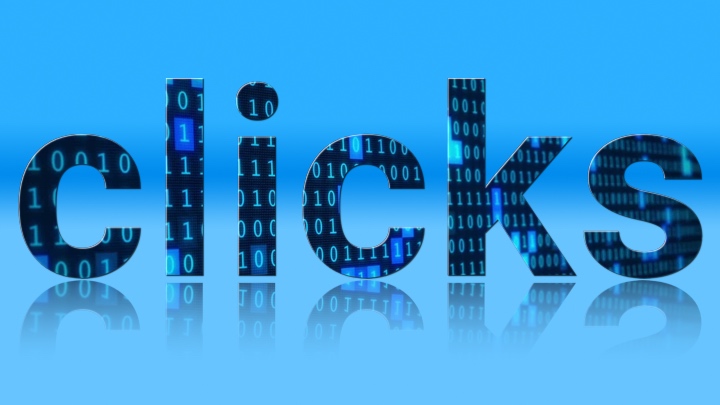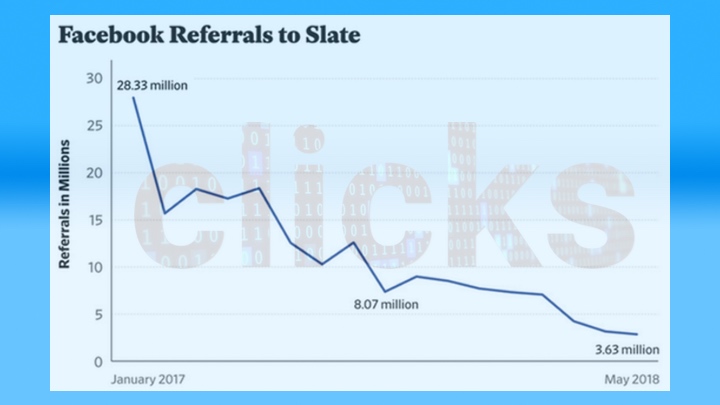The Click-conomy
17 Jul 2018 :: by Jason Jones :: Comments
This article is brought to you by the advertising that brings you Slate.
I started sometimes reading Slate when Slate started publishing stuff to read. Slate, an exclusively online news magazine, was one of the first of its kind. I thought it was going to change the world. Back then I naively thought that just about everything that was happening on the fledgling web was going to change the world.

Oh, M&M’s have their own website now? This is going to change the world!
Of course, the web didn’t change the world (for the better), it just added a thin layer of digi-slime atop the already thick layers of rot and inequality gilding our age. But Slate did manage to stay slightly classier than many of its early peers who have since faded to full spam.
Last month, Slate–rather bravely–published an interesting article analyzing a rapid decline in Slate’s web traffic.

Wow. That is indeed a serious decline in clicks.
And what are clicks? No one knows, but everyone assumes–without evidence–that they are totally worth something.
A rough, back-of-envelope calculation using prevailing ad rates and ad loads (that is, the number of ads a reader sees when she visits a site) suggests that a loss of 15 million visits per month could mean something on the order of $1 million per year in revenue—which, in a newsroom, might equal a dozen or more journalists’ salaries.

180 million clicks are required to produce one million dollars at Slate. So each click is worth about half a penny.
$1,000,000 / (15,000,000 x 12)
The ad load required to produce this half a penny in revenue is nothing short of obscene. When I turn off my ad blocker, this article loads twenty-one ads to the page–including two autoplay videos.

In January 2017, when liberals across the country were at peak panic, Slate reports having had 85 million clicks referred to the site from external sources. Over a full year that would mean that more than a billion clicks were referred to Slate. A billion. That number is more than triple the total population of United States, and those alleged clickers are being served some 20 billion Slate ads per year (a number almost triple the population of the earth).
Maybe Slate is not quite so popular?
We wouldn’t know, because everyone who is part of the click based economy–which is to say, most of the tech and media industries–have an incentive to not think about what clicks are, where they come from, or what they’d be worth if they were suddenly worth only their objective value.

Now serving bots. Bots, party of millions, your table full of ads is ready.
When I asked Facebook about Slate’s decline, a representative told me that its data showed Slate in particular suffered a dip in news feed reach in early 2018 after Facebook made a policy change that prohibited pages from accepting money to share content they didn’t create. Slate was one of several publications that had been paying one such company, the Social Edge, to share its stories via a network of popular celebrity Facebook pages…
So Slate is getting millions of clicks from Facebook’s “News” feed, and yet they’re still buying clicks by misrepresenting ads for their site as genuine contributions from “influencers”.

Wall Street values Facebook at some $600 billion, even though they don’t have any paying customers… and produce no content. That’s ten times the valuation of Ford, five times the valuation of General Electric, and triple the valuation of Netflix. But all Facebook does (not accounting for the dark side privacy violations) is generate clicks, sell ads to those clicks, and then redistribute those clicks for reclicking.
People have finite attention, and try to avoid advertising; yet a large chunk of the NASDAQ’s value is rooted in this same swarm of dubious clicks being repeatedly monetized as an advertising opportunity.

Facebook ads can sell fraud–bigly–but can they sell Hondas? Maybe they can sell a few because the medium of feed advertising is still new enough that most people haven’t yet figured out how to properly ignore them.
Slate ads definitely can’t sell Hondas, but can they sell fraud? I’m not so sure. My educated and experienced guess is that Slate ads are fully worthless. Only a dark cloud of ignorance, and a conspiracy of mutual delusion, allows a half-penny to be collected for showing dozens of ads to a click that will, in most cases, last less than a minute.

The whole click-conomy is a sham. While its epicenter shifts from place to place, by chasing clicks instead of people… it’s destined to completely fail humanity.
One silver lining of the Facebook crash is the emergence of other platforms that have been directing more traffic to many sites in the past year, even as Facebook sends far less. Google, Apple News, Twitter, and Flipboard are all sending more readers to Slate than they used to…
Clicks, not readers.
Of course, if Google returns to referral dominance, that could lead to its own set of unhealthy incentives. (Remember when every news site published the piece, “What Time Is the Super Bowl?”)
“What time is the Super Bowl?” generates a click not a reader. Readers are valuable and important. No matter what you’re talking about, readers are what journalism is all about.
Clicks aren’t readers.
Clicks aren’t people.
Clicks are nothing.

Since 2014 Slate has been selling actual human people memberships in something called Slate Plus for $60 per year. After a spike in membership sign-ups upon the election of Donald Trump, they’re up to a very respectable 25,000ish paying members.
25,000 is somewhat less than a billion.
If all of this click-math is too confusing for you, maybe you should get a loan and buy an expensive degree from one of the for profit colleges that Slate is advertising while pretending to write critically about for profit colleges.

Clicks don’t care about hypocrisy … but people should.

comments